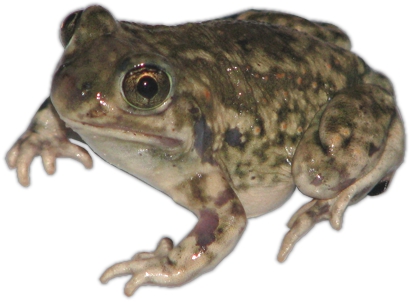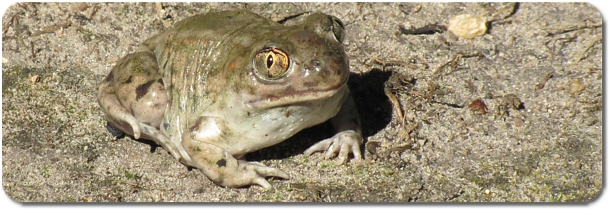Plains Spadefoot
Special Note
The Plains Spadefoot really belongs to another group of toads than our other toads, but it's included with all the toads here.

What it looks like
The Plains Spadefoot is a small toad. The body of an adult can be 4 to 6 cm long. On top they are a light sandy colour, with light brown spots or blotches. The belly is white or cream coloured. They have large, hard bumps, shaped like a spade, under their hind feet.
Look-alikes
The Plains Spadefoot is lighter in colour than the Great Plains Toad and the Canadian Toad. It can be told from all other toads by the large bump under its hind feet and the eyes that have a pupil shaped like a cat's eye.
Name
This animal gets its name from the hard bump under its hind feet. It looks like a spade, a kind of shovel, and helps the toad dig into soft sand. It lives in the plains, or grasslands, of North America.
Scientific Name
The Plains Spadefoot's scientific name is Spea bombifrons. Learn what that means on this page: Scientific Names.
Where it lives
The Plains Spadefoot lives in the grasslands of central and western North America. It lives in the open prairies in areas with sandy soil. In Manitoba it is found only in the southwest part of the province.
Where Plains Spadefoots live in North America.
Habits
Plains Spadefoots are most active at night. By day they hide by digging into soft earth or sand. In late fall, they dig deep into soft sand to spend winter below where the frost can reach.
Food Web
The Plains Spadefoot eats small invertebrates that live on the ground, like ants, beetles or centipedes.
Snakes are the main enemies of Plains Spadefoots. The tadpoles are eaten by water bugs and shore birds. One of the main enemies of Plains Spadefoot tadpoles is other Plains Spadefoot tadpoles! If food is hard to find in the ponds where the eggs were laid, some of the tadpoles will attack and eat the others. This way, at least some of the tadpoles will have enough food to grow to become toadlets.

The "cat's eye" pupil of Plains Spadefoot Toads
is easy to see in bright light.
Life Cycle
Spadefoot Toads live in dry areas and only breed after a heavy rain. They lay eggs in large rain puddles in June or July when the weather is warm.
| Hear the Plains Spadefoot mating call: |
(With some Boreal Chorus Frogs, too.)
Females lay up to 250 eggs. The eggs hatch in 2 days and the tadpoles can become toadlets in as little as 14 days. The faster the water in the rain puddle dries up, the sooner the tadpoles will change to toadlets. The tadpoles change to toadlets that are only about 1 cm long.
Numbers
The Plains Spadefoot is not very common in Manitoba and no one knows how many there might be in each hectare of their habitat.
Special Things
The Plains Spadefoot is a very fast digger. It can use the spade on its hind feet to dig itself backwards into sand in just a few minutes. This is an amphibian that lives in very dry, sandy places.
Spadefoot Toad tadpoles may eat other Spadefoot tadpoles, so that at least some tadpoles will survive.
How to Find Plains Spadefoots
Listen for males calling in late spring to early summer after heavy rains. The best time to hear them is evening, but they may call throughout the day. In dry spells they may remain underground for a long time, so watch for them after heavy rains.
Use by People
This toad has not been studied in Manitoba and not much is known about it. They are not common and are probably not used by people.
| Got to treefrogs: Gray Treefrogs | Back to: Amphibians and Reptiles Front Page |
